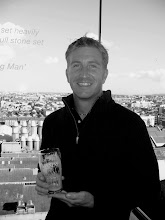
Portland thrives in the shadow of Seattle. The larger town to the north seems to garner all the attention with Grunge, Microsoft, Boeing, and Starbucks. Mr. Cobain ushered out that music scene with a bang, Microsoft is downright evil, Boeing is desperately clinging to its industry and Starbucks is really just in the milk-delivery business.
Perched along the confluence of the Willamette and Columbia rivers, Portland originally started out as a shipping location. WWI and WWII soon demanded an insatiable thirst for timber. And so it has held. No other industry really rose up and took its place. As a result,"Stumptown" was left to fend for its self. This "neglect" has in effect enabled the city to flourish as a modern success story in urban planning (with bicycle's and public transportation leading the charge). Portland is a series of classic neighborhoods, bisected by the Willamette river. Blocks and blocks of old, late Victorian and classic craftsman homes roll on through the grid of narrow streets and giant trees. Portland learned long ago to rely on the locals, seek support inward, become self-sufficient and innovate.

One local business that has thrived in this environment is Stumptown Coffee. A cup of coffee is something entirely different in Portland and this local coffee roaster has become somewhat of an institution. Every day, twice a day this company offers free "tastings" at the their
Annex. These tastings are akin to what people would experience from a visit to a posh winery. One is soon consumed in aromas and educated in the different brewing stages, flavors and techniques that true coffee aficionados require. They encourage you to sip the coffee as loud as you possibly can. It all seems rather silly until you stop to recognize that coffee is the world's second largest (legal) commodity after oil. . .and you really can smell and taste the subtle, fruity and sometimes earthy differences from one bean's offerings to another.

Another local delight that Portland offers are food carts
(link). Scores of them are distributed all over the city that are easily accessible by bicycle. On this beautiful fall day, we decided to do a little "cart crawl" in the downtown area. These carts are run by some fantastic, vibrant and talented cooks that are garnering national attention from food magazines and the NY Times
(link). The result is some of the best street food at affordable prices. Young chefs and cooks get to concentrate on the food, not wait staff, the high rent, liquor licenses and snarky diners.

The first destination was located adjacent to a gas station parking lot and offered the finest fusion of Korean BBQ and Mexican cuisine. For this cart Koi Fusion, you have to follow it's changing location on Twitter. Who knew a Korean / Mexican taco could be so good for $3? Just up the road between the high rises was the second delight. Ziba's Pitas, situated among 20 other carts in a downtown parking lot offered a potpourri of home cooked-Bosnian cuisine. I doubt you could match the flavors and authenticity this side of the Atlantic. And there is something to be said to look the owner, cook, and server in the eye, talk about what is new, fresh and seasonal and watch their face light up and say, "I know just what you will enjoy."




















